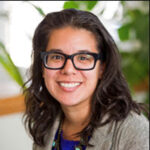This post was written by Christina L. Dobbs and Christine (Chris) Montecillo Leider, based on their article “A Framework for Writing Rubrics to Support Linguistically Diverse Students” (English Journal, July 2021).
Christina
I’m teaching a course in methods in writing pedagogy as part of our master’s program in English education, and teachers in it are grappling with ideas of teaching writing, often for the first time. Class ends at around 9:30, and a student stays after to talk to me about questions she is having. And she says something I’ll never forget—she says that people (me included) keep telling her she needs to shift her perspective about students’ use of diverse language. She says she understands that she must change her own perspective about how students use language they come to school with and that she has ideas for how to talk about language differently in the classroom. But she is frustrated because in her view, we keep saying that she needs to change her perspective, but she has already done that, and what she wants to know is how to provide instruction in such a way that it reflects this new perspective.
In this moment, I feel that she is definitely right, even if I want her to be wrong. I’ve focused so much of my time and energy in the course on changing the beliefs of my preservice teachers, who are mostly white women who don’t have experience in the classroom yet, that I haven’t explained well enough how to do the very work for which I’m advocating. I’ve done a lot of the why but not enough of the how. I don’t have answers in that particular moment, but I resolve to go home and think about better instruction in the how of supporting linguistically diverse learners in classrooms, and not just the why.
Chris
I teach courses on literacy instruction for multilingual learners, and when Christina shared this story with me, I began to think of the number of preservice and inservice teachers who had said something along the lines of, “Chris, I value my students’ languages, and I want them to feel comfortable drawing on their [nonstandard English] linguistic resources, but how do I really let them know it’s okay to do that?” I’ve had this conversation again and again, and many of them ask something similar to what Christina shared: What are the different ways we convey ideas to students about language diversity, and how can we make our values more explicit?
Christina
After speaking with Chris, I think about ways to explore this further with my students. My first idea happens to focus on assessment, because that is what class is about the week following our conversation. I begin to think about rubrics, and how they are a site at which values of what makes writing “good” are transmitted. The first version of the task is just an examination of several rubrics, with a simple question: “What can we discern about what this teacher/team believes about language based on their rubric to assess writing?”
My preservice teachers immediately point toward a few key patterns—that the rubrics say there is correct language and incorrect language, that students are categorized as having “control” over their sentences, and that the rubrics often suggest that students don’t have much agency in writing. As I listen to students making note of these patterns and the messages they send to students, I begin to wonder how we might convey messages more in line with what we know about effective feedback and support for linguistic diversity.
Chris
And so the two of us worked together to develop a guiding framework of questions that teachers can use to ask themselves whether they have been supportive of student writers and their linguistic diversity when giving feedback to their students. Below we share two of the questions included in our framework:
In developing our framework, we wanted a way to communicate to students that they have agency around their language use. Decisions they make around language use are their choice, and we wanted to see rubric language that respects student agency and acknowledges the decisions they make about their writing and language choice. To that end, we offer this question: Does the tool explicitly acknowledge that students have agency in choosing which of their language resources to use?
Writing is an interactive process. We write with a purpose and for an audience, and we wanted that idea to be reflected in rubrics. We hope the following question can guide teachers in acknowledging the connection between language choice and audience: Does the rubric feedback connect student language to audience?
Asking teachers to reframe their rubric language using questions that guide our framework has uncovered many spaces in which we have lots of work to do to “walk the walk” of embracing language diversity explicitly with our students. For more about our framework, please check out our article, “A Framework for Writing Rubrics to Support Linguistically Diverse Students,” in the July 2021 issue of English Journal.
 Christina Dobbs is an assistant professor of English education at the Wheelock College of Education and Human Development at Boston University. Her research focuses on adolescent writing in the disciplines, disciplinary literacy, and teacher professional learning. She is a former English language arts teacher and a reading specialist. Her recent books include Investigating Disciplinary Literacy (2017) and Disciplinary Literacy Inquiry and Instruction (2019). She can be contacted at cdobbs@bu.edu.
Christina Dobbs is an assistant professor of English education at the Wheelock College of Education and Human Development at Boston University. Her research focuses on adolescent writing in the disciplines, disciplinary literacy, and teacher professional learning. She is a former English language arts teacher and a reading specialist. Her recent books include Investigating Disciplinary Literacy (2017) and Disciplinary Literacy Inquiry and Instruction (2019). She can be contacted at cdobbs@bu.edu.
 Christine (Chris) Montecillo Leider is an assistant professor of applied linguistics at the University of Massachusetts, Boston. Her research focuses on bilingual language and literacy practices; policy and civil rights issues regarding teacher training and multilingual learners’ access to education; teacher beliefs about language; and developing bilingual models of reading comprehension. She is a former ESL teacher and can be contacted at christine.leider@umb.edu.
Christine (Chris) Montecillo Leider is an assistant professor of applied linguistics at the University of Massachusetts, Boston. Her research focuses on bilingual language and literacy practices; policy and civil rights issues regarding teacher training and multilingual learners’ access to education; teacher beliefs about language; and developing bilingual models of reading comprehension. She is a former ESL teacher and can be contacted at christine.leider@umb.edu.

